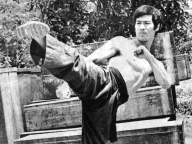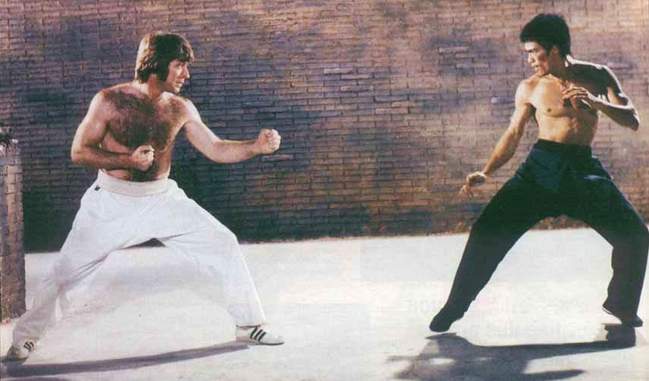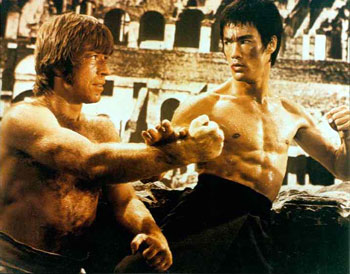How Bruce Lee shaped my ministry (part 3)
So, after an eventful milestone weekend (see my previous post!), it’s back to our look at how the late martial arts master/pop-culture icon, Bruce Lee, has influenced me in my thinking, studies, and overall approach to ministry over the past two decades.
[Click HERE for part 1 and HERE for part 2 if you want to get caught up to speed!]
A key concept in Bruce’s lifelong quest for authenticity in the martial arts involved the conviction that anything superfluous or unnecessary should never cloud one’s training. Core content mattered infinitely more than flashy outer appearances.
Bruce’s own martial philosophy, Jeet Kune Do (JEET-coon-DOH, “Way of the Intercepting Fist”) was built upon this idea all the way to its core:
“Jeet Kune Do avoids the superficial, penetrates the complex, goes to the heart of the problem and pinpoints the key factors.” -TJKD, 12
…
“I hope martial artists are more interested in the root of martial arts and not the different decorative branches, flowers or leaves. It is futile to argue as to which single leaf, which design of branches or which attractive flower you like; when you understand the root, you understand all its blossoming.” -TJKD, 23
For centuries various styles of martial arts had developed traditions, rules, practices, habits or philosophies that, though initially well-meaning and probably useful at some point in time or on some occasion–had assumed the level of dogma among their adherents.
There were endless debates about the “correct” way to practice martial arts or which “style” was superior to all others.
Bruce was one of the few who openly taught that “styles” often consisted of a good deal of extraneous baggage (though there were others, like Gene Lebell, who also recognized this concept). In order to become a better martial artist, Bruce taught that one must be able to see what is core, useful, authentic, and true…and what is secondary, opinion, unnecessary and distracting.
The root was more important than the leaves…and much harder to spot without a lot of digging!
This idea has always stuck with me, even outside of martial arts training.
In so many arguments or debates between people of opposing views, discussion often gets muddied and conversation often gets derailed due to people’s inability to remain focused on the core of what is at stake. In cultural, political or even theological debates over hot-button issues this tendency is all too easily observed.
When politicians debate U.S. foreign policy regarding the war on terrorism, it frequently revolves around issues like where we should station troops, how many we should send, which countries we should trust, how much tax money should we devote and whether or not there should be a timetable for withdrawal upon completion of an objective…yet RARELY is there open and honest discussion of the ROOT causes of modern terrorist attacks and what should be done to attack the heart of the problem (and on rare occasions when someone DOES seek to focus the discussion in that way, they are often met with strong opposition and even boos from the crowd!).
Likewise, when churches or denominations engage debate over controversial issues–such as the recent UM General Conference–the arguments inevitably end up being dominated by rhetorically loaded terms such as “tolerance”, “loving”, “hate”, “inclusiveness”, “progress”, “tradition”, etc. But the core issue in such debates, the ROOT of the conflict, rarely gets discussed clearly and openly (in the case of same-sex ethics, the root issue is not any of those things–rather I would argue the root issue is the degree to which accurate exegesis of Scripture will influence the church’s position on the ethics of behavior that conflicts with its teaching).
Debating and arguing is easy…but if we never “pinpoint the key factors” we end up generating much heat but little light.
We may impress some people with our rhetorical kung-fu…but we do nothing to further anyone’s growth as mature, thinking individuals–including ourselves.
Whenever we face another in battle–be it physically or intellectually–we should fully and genuinely engage them to the best of our ability, with the utmost respect, and seek to grow from the experience, trusting God with the outcome.
One of the reasons I founded Disciple Dojo, therefore, was so that there would be a place where such discussions could happen. Where readers could get to the root of the issues at hand and discuss them openly and in a straightforward manner without needless personal attacks on their character, hollow name-calling, or endless sidetracking and rabbit-trails.
Thus, we’ve been able to have excellent and thought-provoking discussions over:
- views Christians should have toward modern Israel…without anyone being met with charges of “anti-Semite”, “religious fanatic” or “Godless liberal”
- the unethical nature of abortion-on-demand…without anyone being called a “baby-killer” or “anti-choice”
- whether the death penalty is justifiable…without assuming that those who disagree don’t read their Bibles
- and even the emotionally-charged issue of same-sex sexual relationships in both the church and in secular society…without the usual charges of “hate”, “bigotry”, “degenerate” or “depraved” being lobbed from rhetorical barbed-wire bunkers.
No matter what the issue is–be it predestination or premillennialism–it is crucial that one keep the focus on what is at the root or core if any thoughtful discussion is to take place.
Yes, this may require some intellectual digging.
Yes, it’s easier to play with or become enamored by the leaves. But to understand the root is to understand all its multicolored blossoms.
May we constantly seek to dig, and spur one another on to do likewise.
Continue to Part 4
Categories: Arts and Culture, Blog, Martial Arts, Ministry, Theological issues



Wow…excellently written, champ! I agree on all points (and that’s rare). Keep writing. And I’ll surely keep reading!!
by Marvin D. Rogers on Sep 11, 2012 at 4:40 am
I’ve always been drawn to the core of things. The basis. The essence. The fundamental principle. This drew me to Bruce Lee, to our brother Yusef, and to you, my friend. I pray that we may always see and experience the essence of reality.
by Olatunde on Sep 11, 2012 at 8:39 pm
[…] For part 3 (getting to the root) click HERE. […]
by Disciple Dojo – JMSmith.org » How Bruce Lee shaped my ministry (part 5) on Oct 5, 2012 at 11:33 pm